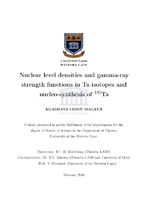| dc.description.abstract | Most stable and extremely low abundance neutron deficient nuclei with Z ≥ 34 are referred to as p-nuclei. Nearly all p-nuclei with A < 110 are most likely produced in the rp-process while almost all A > 110 are thought to be produced by the photodisintegration of s- and r- process seed nuclei. However, for some nuclear systems, these processes are not sufficient to explain their observed solar abundance. Results from calculations in ¹⁸ᴼTa generally provoke debates since several processes are able, sometimes exclusively, to reproduce the observed ¹⁸ᴼTa abundance in the cosmos, making it a unique case study. Some of the main sources of errors in the predicted reaction rates of ¹⁸ᴼTa arise due to the absence of nuclear data or due to large uncertainties in the nuclear properties such as the nuclear level densities (NLD) and gamma-ray strength functions (γSF) of ¹⁸ᴼ,¹⁸¹Ta. The NLD and γSF are primary ingredients for astrophysical reaction rate calculations based on the Hauser-Feshbach approach. These parameters need to be well understood to improve our
understanding of ¹⁸ᴼTa production in astrophysical environments. In this thesis, new experimental data for the low-energy part of the γSF and NLD in ¹⁸ᴼ,¹⁸¹Ta were extracted, using the so-called Oslo method. An experiment was performed and the NaI(Tl) gamma-ray array and silicon particle telescopes at the Oslo cyclotron laboratory were utilized to measure particle-γ coincidence events from which the NLDs and γSFs are extracted below the neutron separation energy threshold Sn. A beam of ³He was used to populate excited states in ¹⁸ᴼ,¹⁸¹Ta through the inelastic scattering (³He,³He’𝛾)
and the transfer reaction (³He,𝜶𝛾). Based on results from this measurements, the Maxwellian averaged (n, 𝛾) cross sections for the 179Ta(n, γ) and ¹⁸ᴼTa(n, 𝛾) reactions, at the s-process thermal energy of kT = 30 keV (i.e. a temperature of T = 3.5 × 10⁸ K) and p-process thermal energy of 215 keV (T = 2.5 × 10⁹ K), respectively, were computed with the TALYS reaction code. These results can be used to place the nuclear physics aspects of the large network abundance calculations on a solid footing and have potential to improve our understanding of the astrophysical processes and sites involved in the production of nature’s rarest isotope ¹⁸ᴼTa. | en_US |

